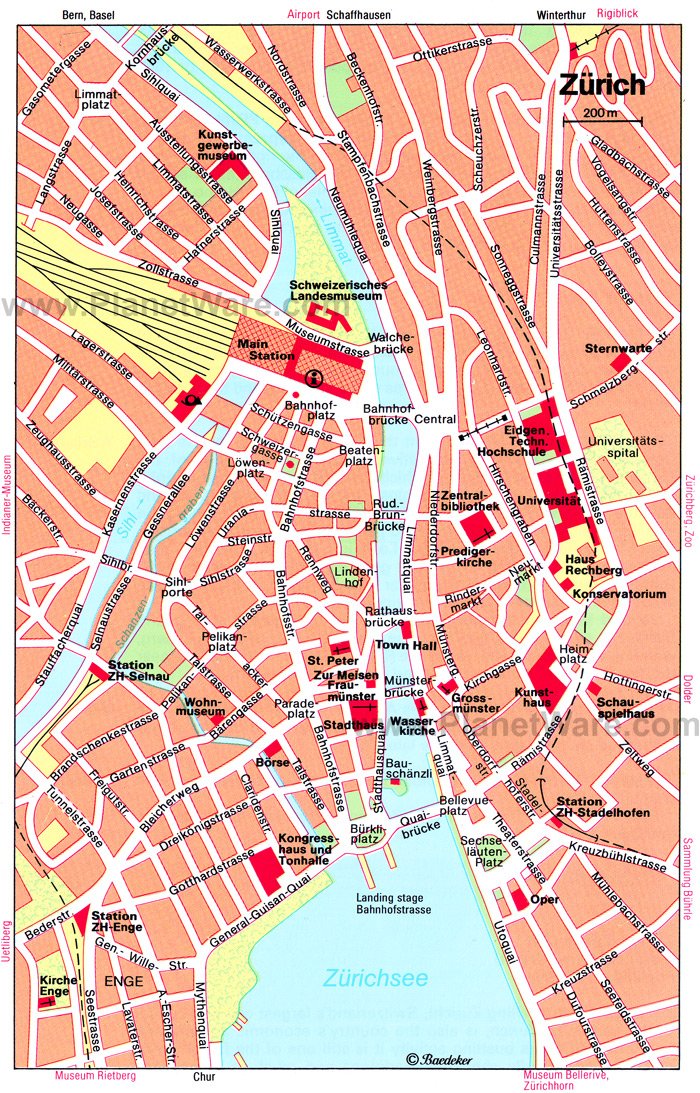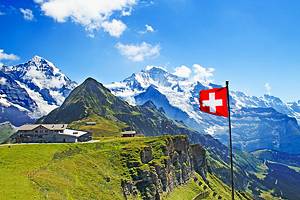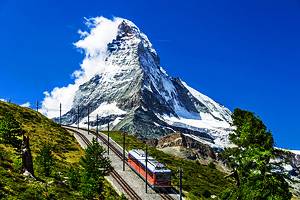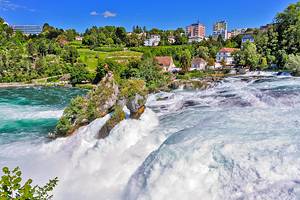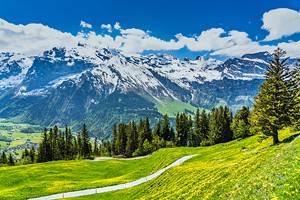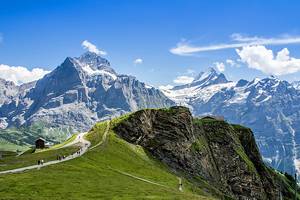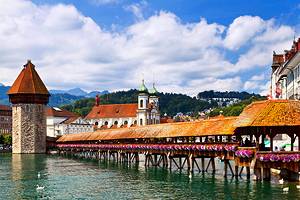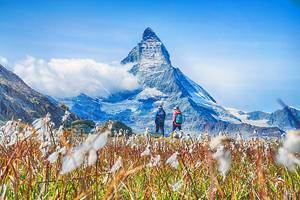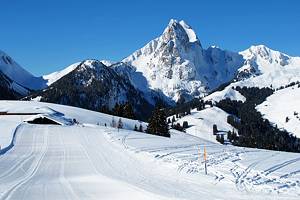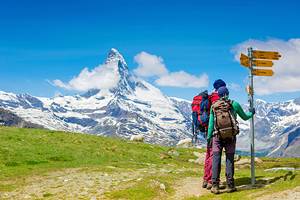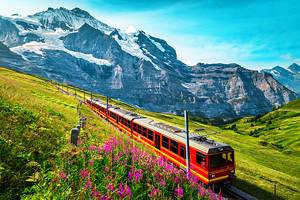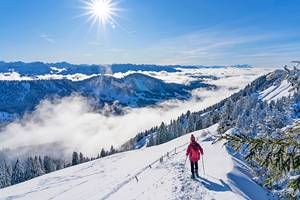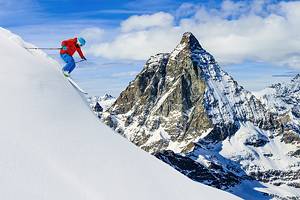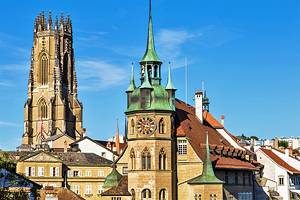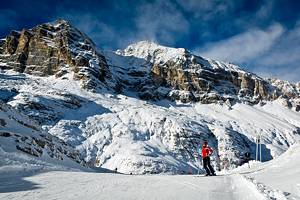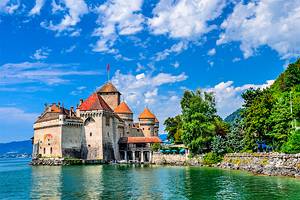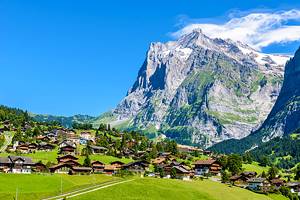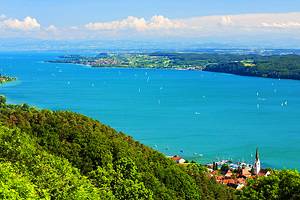Tourist Attractions in Zürich
Zürich, Switzerland's largest city, is a delightful and fascinating place for tourists. Its many attractions and things to do include dozens of museums, a well-preserved old town filled with medieval and Renaissance buildings, and enough art - both in and out of museums - to keep art lovers happy for a week.

Zurich's tradition of liberal thinking and active intellectual life attracted leading figures that included Georg Büchner, Vladimir Lenin, James Joyce, C. G. Jung, and Thomas Mann, and this tradition continues into modern times. Although it buzzes with business activity, Zürich is one of the finest Swiss cities to visit and is perfectly arranged for sightseeing on foot.
The city is also a good base for visiting many other fascinating places in Switzerland and the nearby Black Forest region of Germany. In fact, a number of these make good day trips from Zürich.
Niederdorf and the Old Town

In the midst of this modern financial powerhouse of a city is a neighborhood filled with historic charm, its narrow streets rising steeply on the east side of the river. The Niederdorf area is one of the medieval streets and squares, a lively place to visit, with boutiques, restaurants, and cafés.
Wander up from the Limmat River area to the Old Town, a delightful area to stroll around and explore streets at random. If you get lost, which is half the fun, head downhill and you'll end up at the river.
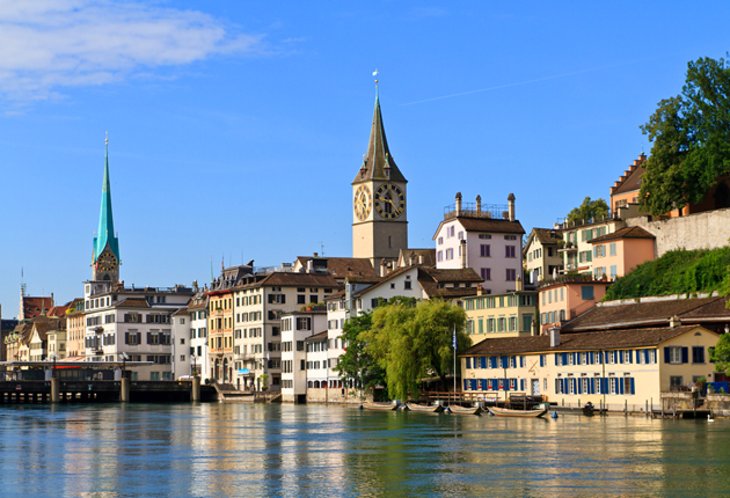
Some of the highlights can be found by walking up Münstergasse. You'll come to the Napfgasse, with the Brunnenturm, which was the headquarters of the Lombard money-changers in the 14th and 15th centuries. Haus zum Napt, at number 6, has a fine interior with rooms furnished in Renaissance style.
On Spiegelgasse, at number 17, is a house where Lenin lived in 1917. On this street, at Cabaret Voltaire, Hans Arp and Tristan Tzara launched the Dada art movement in 1916. Spiegelgasse runs east into the Neumarkt, where you'll find the Shoemakers' Guild House, now a theater, and the Hans zum Rech, dating from the Middle Ages and showing how decorative styles changed over the centuries.
Step inside at least to see its courtyard and the model of Zürich in 1800. The interior preserves painted walls and ceilings from the 17th century and fine ornamental ironwork. The 13th-century Grimmenturm, at number 27, was originally a residence. In these streets, you'll find antique shops and boutiques, as well as cafés and restaurants.
If you work up a thirst during all your exploration, fill your water bottle at one of the beautiful public fountains. There are over 1,200 in Zürich, and the water is clean, safe, and fresh.
Ride the Train up the Uetliberg
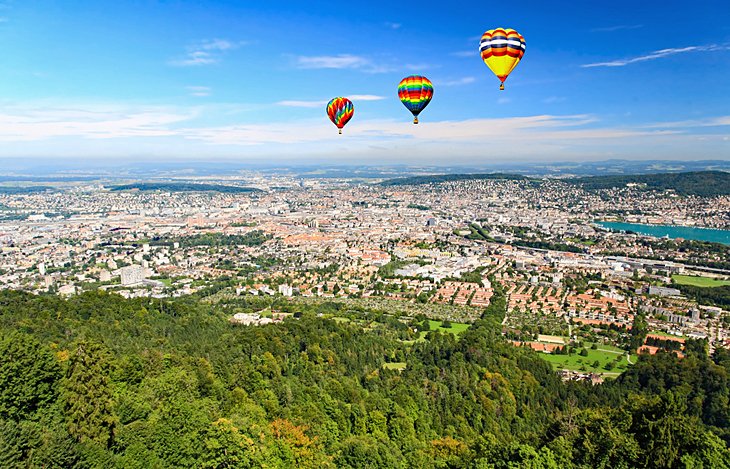
For the best views of the city and the lake, follow locals to their favorite weekend aerie, the 871-meter Uetliberg. Southwest of Zürich, the Uetliberg is the most northerly summit in the Albis ridge, easy to reach by the Uetlibergbahn, a mountain railroad that runs year-round from Selnau station to the upper station. From here it is a 10-minute walk to the summit.
The broad walkway is well-lit at night and leads to the summit restaurant, a glass-enclosed space with beautiful views of the city lights below. Daytime views from the lookout tower stretch across the Valais, Bernese, and Glarus Alps, with the Black Forest to the north and the Säntis to the east. From here, an easy ridge walk to the Felsenegg takes a little more than an hour, where a cableway descends to Adliswil.
You can return to Zurich by the Sihltalbahn. Riding to the Uetliberg at night for a dinner of fondue and views of the city with its lights reflected in the snow is one of the locals' favorite things to do in Zürich in the winter.
Explore Lake Zürich

The focal point of Zürich, and a favorite playground for tourists and locals is the long Lake Zürich. The entire shore is lined with promenades and parks, where local residents catch the sun, jog, picnic, and swim in the lake.
The favorite way for tourists to enjoy the lake is on one of the many cruises that reveal beautiful views to the Glarus Alps. Look for the steamer landing at Bürkliplatz, at the point where the Limmat flows from the lake. The Quaibrücke crosses the river to connect Bürkliplatz with Bellevueplatz.
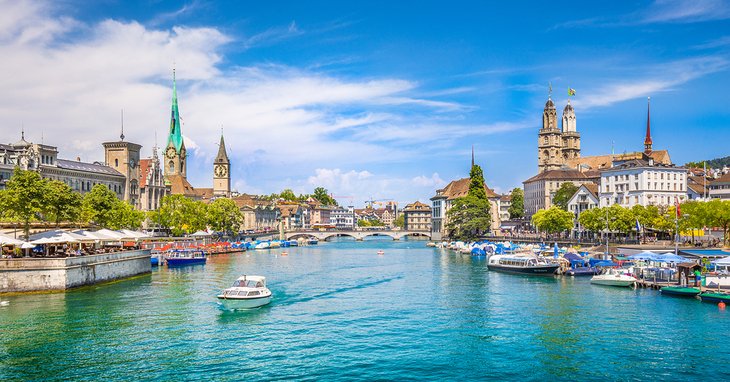
If you have a bit more time and are looking to save some money, a much cheaper cruise option is to take the public ferries on lines N1, N2, and N3. The historical vessels are comfortable and beautiful and stop at all the main attractions on Lake Zürich. Tickets can be purchased at the docks or in advance on the ZSG (Zürichsee-Schifffahrtsgesellschaft) website.
On the opposite shore, Strandbad Mythenquai is a public beach, part of the Seeuferanlage promenades that were built between 1881 and 1887. The 820 feet of sandy shore has diving boards, children's pools, lawns for sunbathing, barbecue sites, and a self-serve rental station for paddleboards.
A large flea market is held every Saturday on Bürkliplatz from May until October with as many as 500 vendors, including antiques dealers and hobby traders.
Walk along the Lakeshore to Zürichhorn Park

One of the most popular and free things to do in Zurich is to stroll along the Historische Quais am Zürisee to Zürichhorn Park. Along the way, you'll be treated to spectacular views across the lake to the snow-capped mountains off in the distance. Leaving from Bellevueplatz by the Zurich Opera House the 1.5-kilometer walk follows the shoreline under shade trees. Along the way are small restaurants and patios, perfect for grabbing a snack and relaxing in the sun.


At the end of the walk is the beautiful Zürichhorn Park, built for the National Exhibition in 1939. Here, you'll find a restaurant; a Chinese Garden; and a boat landing for the Limmatschiff, a boat that runs from the National Museum along the river to the lake, ending at Zürihorn.
Located right next to the Chinese Garden is the Heidi Weber Museum (Le Corbusier House). This colourful building is the last major work by the famous architect Le Corbusier and is considered an architectural jewel.
The views from the southern end of Zürichhorn Park near the ferry terminal across Lake Zurich are spectacular on a clear day.

You can walk back along the shoreline or pop up to Seefeldstrasse and jump on a tram back to the Opera House area where you'll find good restaurants with lively patios.
Kunsthaus Zürich (Museum of Fine Arts)
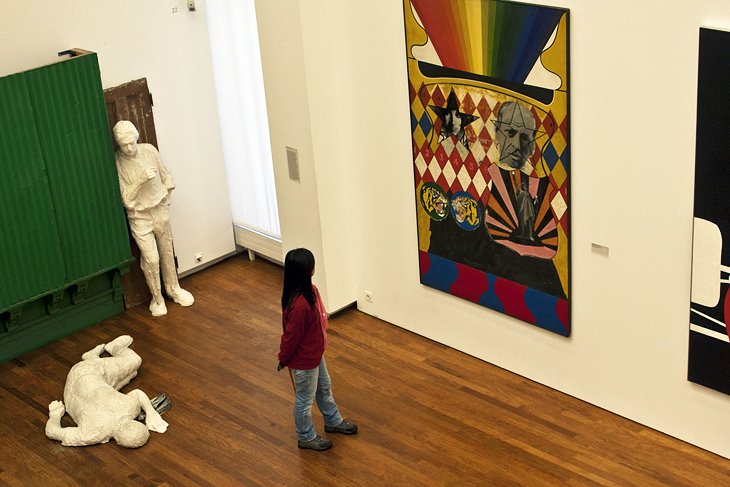
One of Europe's top art museums, the Kunsthaus is run by the Zürich Society of Arts and traces its history back to a society of artists founded in 1787. While it has large collections of works by several artists - more paintings by Charles Munch than any other museum outside of Oslo and Europe's most important collection of Monet's works outside of Paris - the emphasis has always been on showing the highest quality works by an artist over the largest quantity.
In October 2021, a new extension by architect David Chipperfield opened across the square, linked by an underground passage. This expansion doubled the museum's gallery space and now includes the classic modernist collection, the Bührle collection, and temporary exhibitions.
The Kunsthaus is especially strong in Impressionists, Post-Impressionists, and Modern schools, beginning with the forerunners and early Impressionists Delacroix, Corot, Courbet, and Manet. Two of the most beautiful of the large water lily canvases are at the center of the Monet exhibit. Both Cézanne and van Gogh are represented by paintings from the end of their careers - van Gogh's painted in the final days of his life. An entire room is filled with characteristic dreamlike works of Marc Chagall.
Landmark works of Mirò, Max Ernst, Magritte, and Salvador Dali represent the Surrealist artists, and Matisse is featured both as a sculptor and painter. As you might expect, there are numerous works from the Dada school, begun right here in Zürich. Earlier periods are well represented, with important collections of exceptional paintings from the Dutch Golden Age, the Flemish (Rubens and van Dyck), Italian Baroque, and the Venetian Settecento periods.
Again, the emphasis is on landmark works, such as Domenichino's first great landscape painting of the Baptism of Christ, considered a milestone in landscape painting. Obtaining works of living artists is an important mission, and on the ground floor, you'll find changing exhibits of contemporary sculptures.
Address: Heimplatz 1, Zürich
Official site: http://www.kunsthaus.ch
Bahnhofstrasse and the Bahnhof
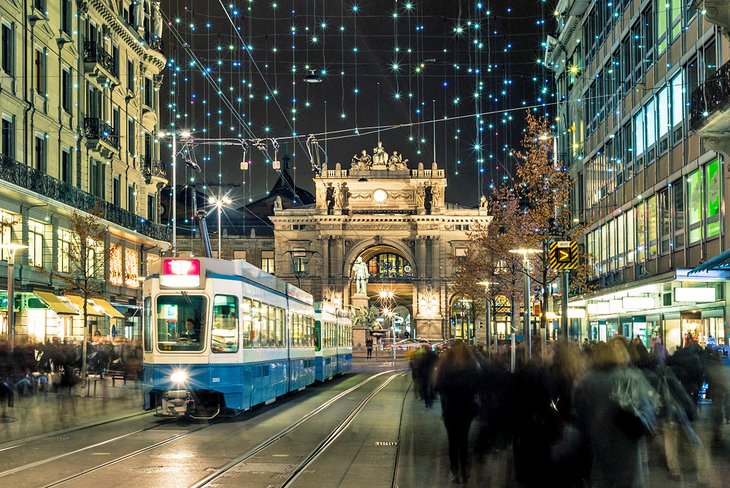
Zürich's "Main Street" is the busy pedestrianized Bahnhofstrasse, stretching from the main train station (bahnhof) to the Bürkliplatz at the head of the lake. The 1,200-meter street is one of the most attractive shopping streets in Europe, enlivened by fountains, public art, trees, and distinguished buildings.
Although many of the shops that line it are filled with furs, fashions, jewelry, and other high-end goods, their smartly decked windows and the buildings themselves make it a popular place for everyone to stroll. The middle section of the street was built in 1867 after the filling in of an old moat, the Fröschengraben; the parts towards the lake and the station were built a few years later.
Among the interesting buildings are several dating from the turn of the 20th century: the Weber building (number 75), rebuilt in 1912 and 1928, and the former Jelmoli department store complex (the store closed in 2024) at Seidengasse 1, originally designed with a skeleton in iron. Notice especially the 1913 facade of the Peterhof and Leuenhof building.
In the basement of Bahnhofstrasse 31, the Uhrenmuseum Beyer Zürich displays a large collection of watches and clocks, ranging from sun, oil, and water-clocks to Swiss clocks with wooden wheels and Nuremberg pendulum clocks. In the lower part of Bahnhofstrasse is the Paradeplatz, with the palatial 1876 headquarters of the Schweizerischen Kreditanstalt and the Hotel Savoy Baur en Ville, built in 1838 and reconstructed in 1978.
In the 18th century, there was a cattle market on the Paradeplatz, and later it was used as a parade ground. The imposing Bahnhof itself is an attraction, its soaring hall lined with shops and cafes, with more in the giant mall underneath. Zurich's largest Christmas market is held inside the Bahnhof.
Fraumünster
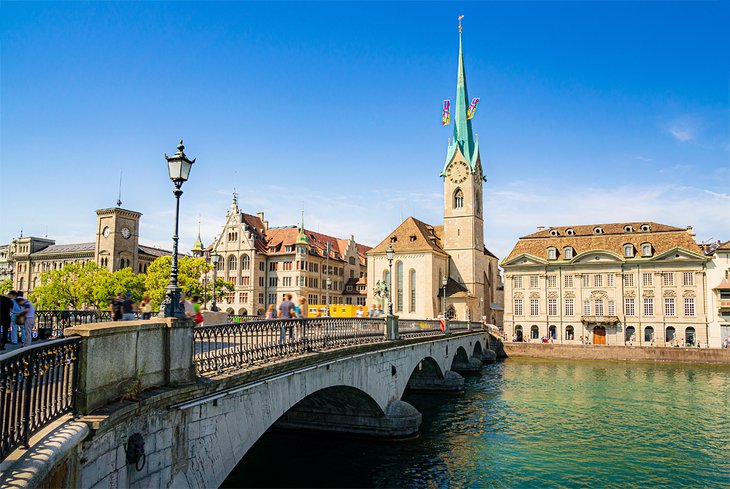
Often mistranslated to Church of Our Lady, the name of the protestant Fraumünster actually means Women's Church, referring to the founding of an abbey here in 853 for aristocratic women of Europe by the Emperor Ludwig for his daughter, Hildegard. Until the high Middle Ages, the head of the convent was also governor of the city.
The church is a three-aisled, pillared basilica with a Gothic nave built from the 13th to the 15th centuries, a Romanesque chancel, and an Early Gothic transept with high vaulting. In the undercroft, you can see the remains of the crypt of the 9th-century abbey church.
Although the church itself is worth seeing, what makes it one of Zürich's most popular tourist attractions is the beautiful set of five stained-glass windows in the chancel created by Marc Chagall in 1970. From left to right, the vividly colored windows show Elijah's ascent to heaven, Jacob, scenes of Christ's life, an angel trumpeting the end of the world, and Moses. It's ideal to visit on a sunny day to see the windows at their brightest.
The rosette in the southern transept is also the work of Marc Chagall. In the north transept is another impressive stained glass window, The Heavenly Paradise, created by Augusto Giacometti in the 1940s. The abbey itself was demolished in 1898 to make way for the Stadthaus, but the Romanesque and Gothic cloister survives, with 1928 paintings by P. Bodmer illustrating the legend of the convent's founding and the city's patron saints, Felix and Regula.
Address: Münsterhof, Zürich
Lindenhof
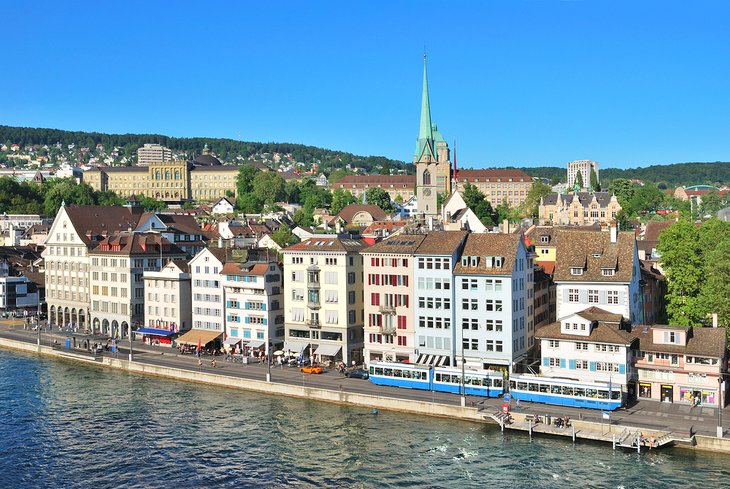
Between the Bahnhofstrasse and the left bank of the Limmat, the western half of Zürich's old town rises steeply to the quiet tree-shaded Lindenhof. This is where the Romans built their fortified settlement in the fourth century to defend against migrations from the North. Five centuries later, the grandson of Charlemagne built a palace here as a royal residence.
Long after remains of these structures had all but disappeared, some incorporated into buildings around the park, the site was still used for important ceremonies; in 1798 the oath confirming the Helvetic Constitution was taken here. Today, it's a tree-shaded park with benches, chess players, and tourists enjoying the sweeping views across the river and Old Town.
Limmatquai and the Rathaus (Town Hall)
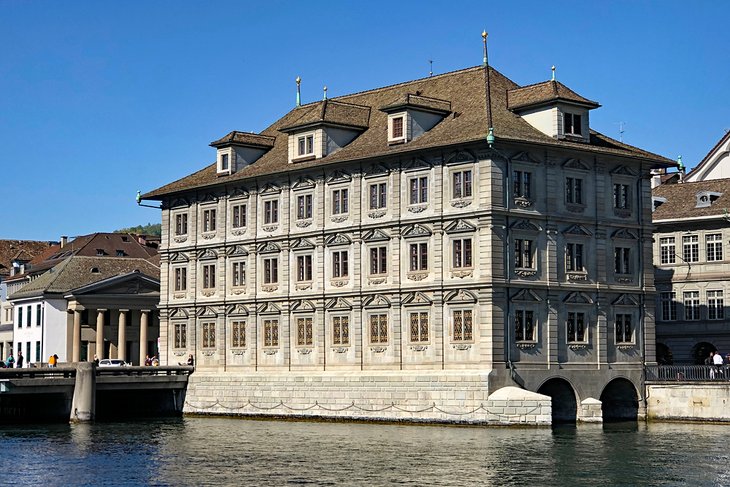
Along the Limmatquai, a popular riverside shopping street, are a number of elegant old guild-houses with sumptuous interiors reflecting the wealth of the guilds which governed the town until 1789. Many of them now house restaurants, so you can get a look inside at the 1719 Haus zur Saffran (number 54); the 1660 Haus zur Rüden (42); and the two-storied Haus zur Zimmerleuten (40) from 1709, with a beautiful oriel window.
Zürich's Town Hall, the Rathaus, is easy to spot, as it overhangs the river and is supported on wide arches at the east end of the Rathausbrücke. Constructed between 1694 and 1698, the massive Late Renaissance building has rich sculptured decoration and a Baroque ceremonial hall that is well worth seeing.
At the end of Münsterbrücke stands the Late-Gothic Wasserkirche, once entirely surrounded by the River Limmat. It was not connected to the land until 1839 when the Limmatquai was constructed. Built onto the north side of the church is the 1794 Helmhaus with an open fountain hall in which special exhibitions are held.
Schweizerisches Landesmuseum (Swiss National Museum)
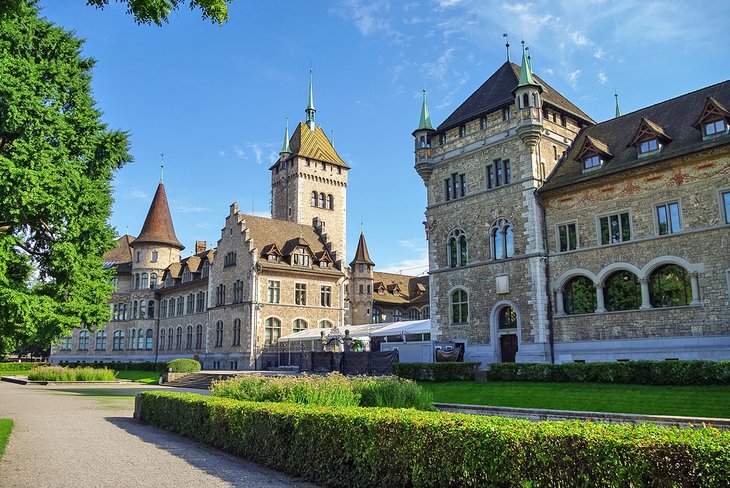
A castle-like building with neo-Gothic flourishes houses an excellent museum showcasing the cultural history of all of Switzerland. It is by far the most important collection of Swiss historic and cultural artifacts - more than 820,000 of them, covering a wide range of subjects from prehistory through the 20th century.
The archaeological collections, with artifacts discovered in Switzerland that date from about 100,000 BC to about AD 800 are among the finest in Europe. Entire collections cover works of gold- and silversmiths, textiles, costumes, metalwork, jewelry, watches and clocks, scientific instruments, rural life, carriages and sleighs, musical instruments, crafts, and industrial antiquities.
The medieval wall paintings are particularly interesting, as is the collection of old stained glass. The Armory Tower exhibits an important collection of arms and armor.
Displays follow four themes: early migration and settlement, religious and intellectual history, political history, and the economic development of Switzerland. The Collections Gallery provides an overview in 20 displays showing Swiss handicrafts and products.
A series of reconstructed period rooms, for which the museum is best known, shows furnishings and decorative arts in room settings following the evolution of living spaces through the centuries as needs and tastes changed. Swiss furniture from the 20th century is displayed as well, highlighting the contrasts.
Be sure to visit the permanent exhibition, 'Simply Zurich.' Located on the top floor, this free exhibit offers a concise and engaging history of the city.
Address: Museumstrasse 2, Zürich
Official site: https://www.landesmuseum.ch/en
Grossmünster (Great Minster)
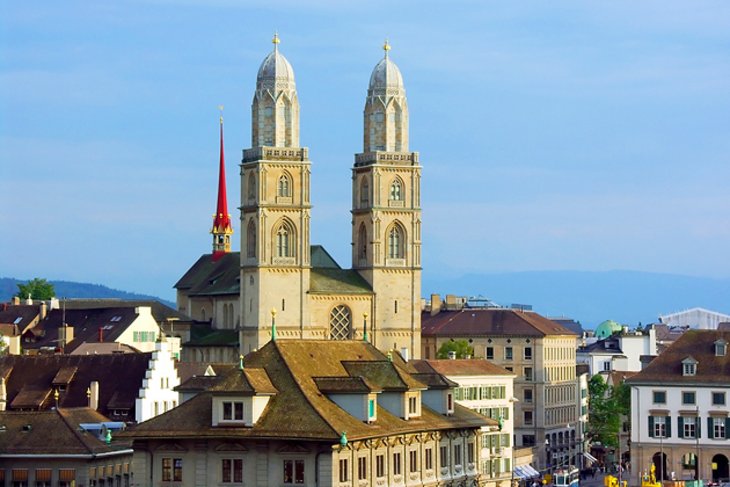
Standing on an open terrace above the river, Zürich's principal church dominates the city skyline with its twin towers. Built between the 11th and the 13th centuries, it is a Romanesque three-aisled galleried basilica with a chancel over a crypt that dates from about 1100. The upper levels of the towers date from 1487, but the domed tops were added in 1782.
You can climb the towers for what is arguably the best panoramic view over the Old Town, the lake, and the river.
High on the south tower on the riverside is a seated figure of Charlemagne, who is believed to have founded the order to which the church originally belonged. You can see the badly weathered original of the statue in the crypt; the outside one is a copy.
Be sure to see the two modern bronze doors done in 1935-36, the sculptured Romanesque capitals, remains of Gothic wall paintings, and the Late Romanesque cloister from about 1200. The three vividly colored stained-glass windows in the choir were designed by Augusto Giacometti in 1933.
FIFA Museum
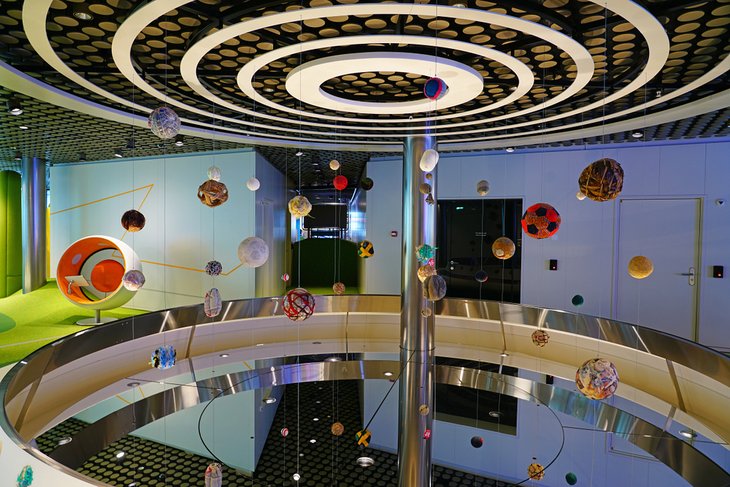
Football (soccer to Americans and Canadians) is the world's most popular sport, played in every country, and the FIFA Museum tells the story of its world governing body and of the World Cup. The immersive experience begins with giant video screens showing football being played in countries throughout the world.
At the 13-meter-long Time Line exhibit, visitors can watch the sport grow as country after country joined.
The largest exhibition space is devoted to the FIFA World Cup Gallery, filled with mementos and the history of the two most important competitions: the FIFA World Cup and the FIFA Women's World Cup. The highlights for fans are a close-up look at the glittering World Cup Trophy and a film with the most memorable moments from the World Cup Finals.
Address: Seestrasse 27, Zürich, Switzerland
Official site: https://www.fifamuseum.com/en/
Zurich Zoo
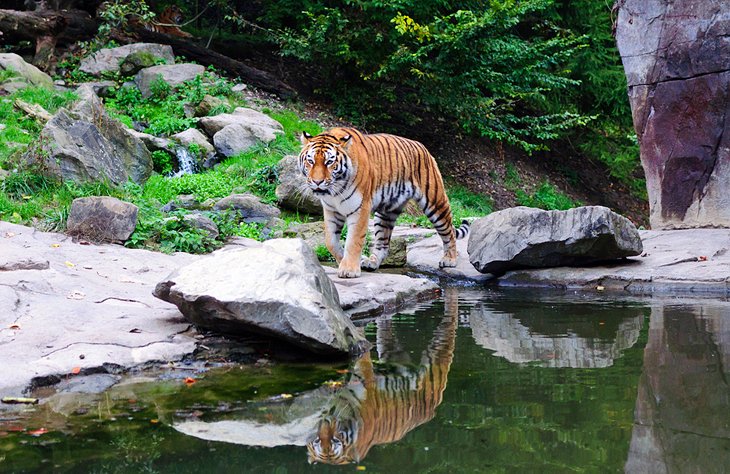
More than 360 different animal species live in the exotic world of the Zurich Zoo, one of the finest in Europe. Animals live as close to their own environments as possible: snow leopards amid the rocky Himalayan landscape, penguins swimming in chilly water, and you can spot flying foxes from a canopy walk amid 13,000 square meters of tropical rainforest.
In the Kaeng Krachan Elephant Park, you can watch the Asian elephant family play with their baby and swim in their multi-environment outdoor complex, which was designed to resemble their natural Thai habitat. Trams and trains run to the zoo from the main train station and the Paradeplatz.
Address: Zürichbergstrasse 221, Zürich
Official site: https://www.zoo.ch/en
Zurich-West
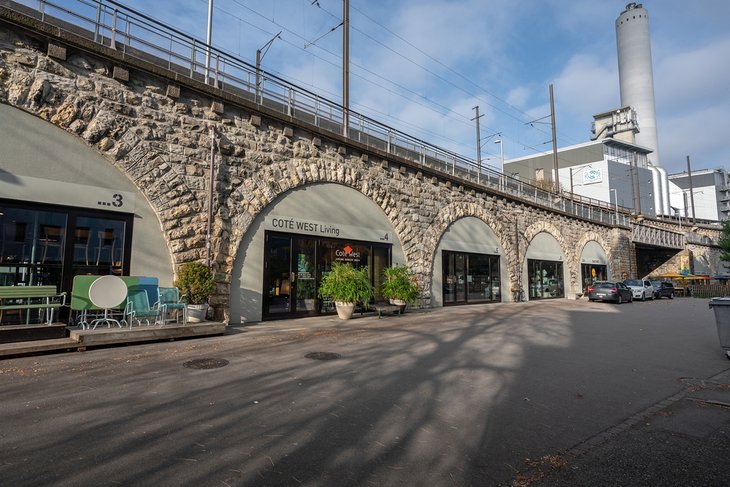
Reinventing itself from a former industrial area, Zurich-West is now a trendy district for contemporary art, design, shopping, and dining with an informal vibe and cheeky charm.
The main gathering point is under the arches of the railway viaduct, built in 1894 and known as Im Viadukt. The arches are now filled with designer shops, boutiques, a food market, and restaurants, and the 500-meter-long urban space alongside it is the place to stroll.
The Freitag Tower is worth a stop. This is the flagship store for the famous messenger bag company, constructed from 19 stacked shipping containers and featuring a viewing platform on top.
Kunsthalle Zurich and Migros Museum both feature contemporary art, the latter of them with a focus on social issues. The former shipbuilding plant, the Schiffbau, is the major venue for performing arts and music.
Rietberg Museum
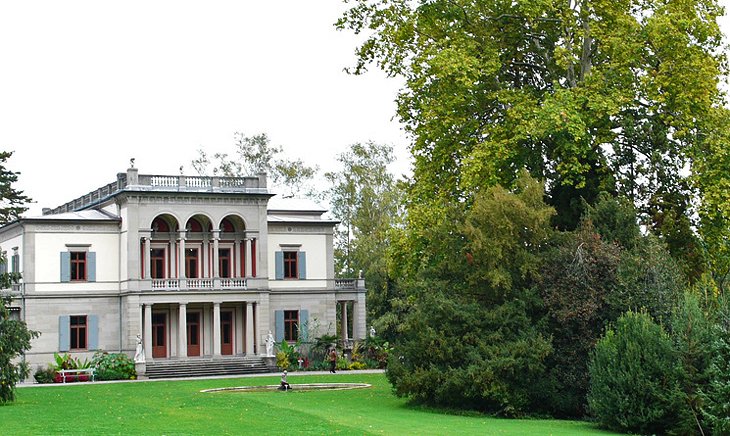
A Neoclassical villa modelled on the Villa Albani in Rome (it's said to be an exact copy) houses the outstanding collection of Baron Eduard von der Heydt. The villa was built in 1857 for a German industrialist and was a meeting place for Zürich intellectuals. This historical villa contrasts with the beautiful, modern green-glass extension known as the "Smaragd" (Emerald).
It is Switzerland's only museum of non-European art, with collections that include Indian sculpture, Tibetan temple pictures and bronzes, Chinese grave decorations, Buddhist stele, and Asian ceramics and jade. There are also arts from the Pacific, the Near East, and North America, along with a collection of African carvings, masks, and bronzes.
The villa sits in beautiful Rieter Park, an English landscape garden with walking paths.
Address: Gablerstrasse 15, Zürich
Official site: www.rietberg.ch
St. Peter's Church
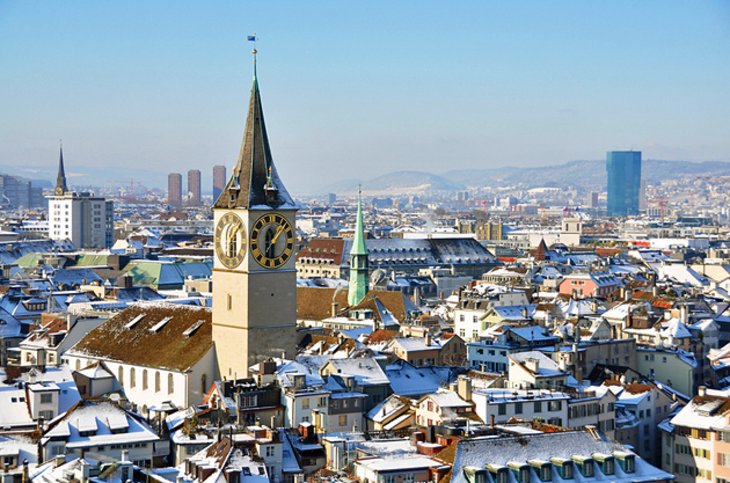
South of the Lindenhof in the part of the Old Town that lies on the west bank of the Limmat, St. Peter's Church stands on a little hill. The oldest parish church in Zürich, it has an early 13th-century Romanesque choir under the tower and a Baroque nave with three aisles and galleries.
You can see the original 9th-century foundation underneath the chancel. In 1538, the church acquired the largest clock dials in Europe, 8.7 meters in diameter, and still holds that record.
Address: St.-Peter-Hofstatt, Zürich
Confiserie Sprüngli: A Confectioner's Café
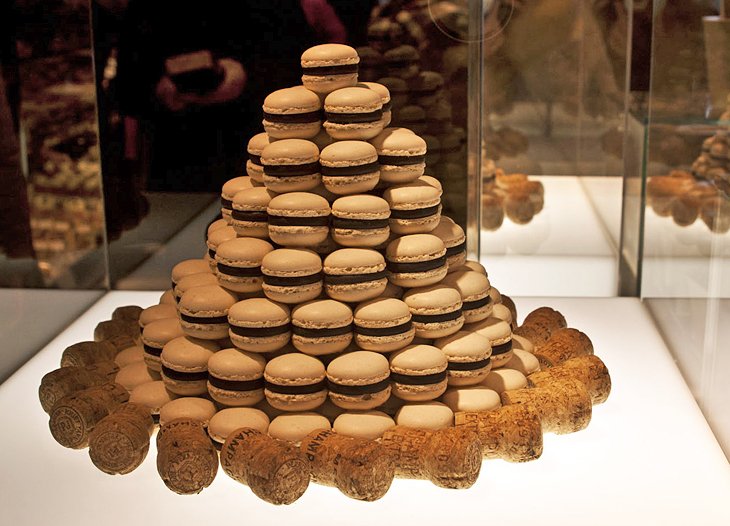
Sprüngli House was opened in 1856, and today, the confectioner's café on Paradeplatz is a favorite stop for locals and tourists. One look at the stacks of temptations in the window, and you'll be drawn inside to at least feast your eyes on the beautifully displayed truffles (made fresh each day), bonbons, cakes, and their signature macarons, called Luxemburgerli.
The retail shop is on the street floor, while the upstairs café-salon serves breakfast, lunch, and afternoon desserts in genteel surroundings. For a quintessential Swiss breakfast experience, try the Birchermüesli, a dish invented in Zürich by Dr. Maximilian Bircher-Brenner around 1900.
Address: Bahnhofstrasse 21, Zürich
Zurich Christmas Markets
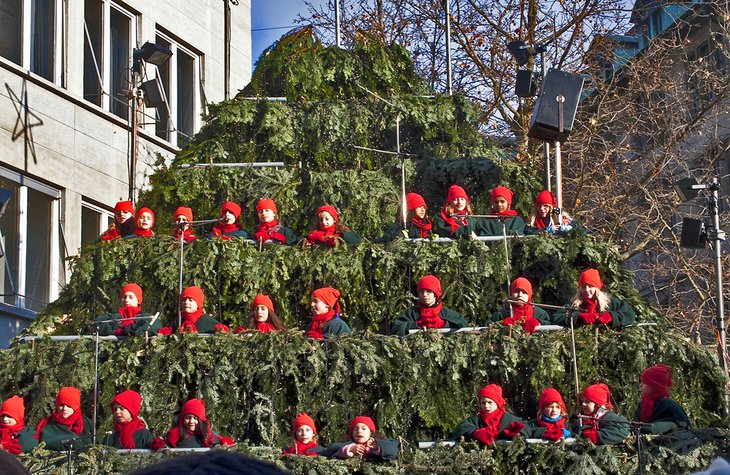
The month of December is an exciting time to visit Zurich, when streets and squares - even the train station - are filled with kiosks selling holiday foods, gifts, decorations, and works by local craftspeople. Amid the stalls in Werdmühleplatz is the Singing Christmas Tree, a pyramid-shaped platform of evergreen boughs where rows of red-clad children sing Christmas carols.
At Bürkliplatz, visitors can create their own Christmas candles, and throughout the markets are carousels and amusements for children.
One of Europe's largest Christmas markets fills the huge Bahnhof, whose main hall becomes a glittering world of lights, highlighted by a 50-foot Christmas tree decorated entirely with Swarovski crystal ornaments. The tree showcases more than 6,000 ornaments from the year's latest and from past years.
A short boat ride on Lake Zurich to Medieval Rapperswil adds a Christmas market featuring a wide variety of local foods.
Zurich, Switzerland - Climate Chart
| Average minimum and maximum temperatures for Zurich, Switzerland in °C | |||||||||||
| J | F | M | A | M | J | J | A | S | O | N | D |
| 10 -10 | 11 -8 | 16 -6 | 22 -2 | 25 2 | 28 6 | 30 8 | 29 8 | 25 5 | 20 0 | 16 -4 | 11 -8 |
| PlanetWare.com | |||||||||||
| Average monthly precipitation totals for Zurich, Switzerland in mm. | |||||||||||
| 69 | 71 | 71 | 89 | 104 | 125 | 119 | 135 | 94 | 69 | 81 | 76 |
| Average minimum and maximum temperatures for Zurich, Switzerland in °F | |||||||||||
| J | F | M | A | M | J | J | A | S | O | N | D |
| 49 13 | 51 17 | 61 22 | 70 29 | 77 35 | 82 42 | 85 46 | 84 45 | 76 40 | 68 32 | 60 24 | 51 16 |
| PlanetWare.com | |||||||||||
| Average monthly precipitation totals for Zurich, Switzerland in inches. | |||||||||||
| 2.7 | 2.8 | 2.8 | 3.5 | 4.1 | 4.9 | 4.7 | 5.3 | 3.7 | 2.7 | 3.2 | 3.0 |
